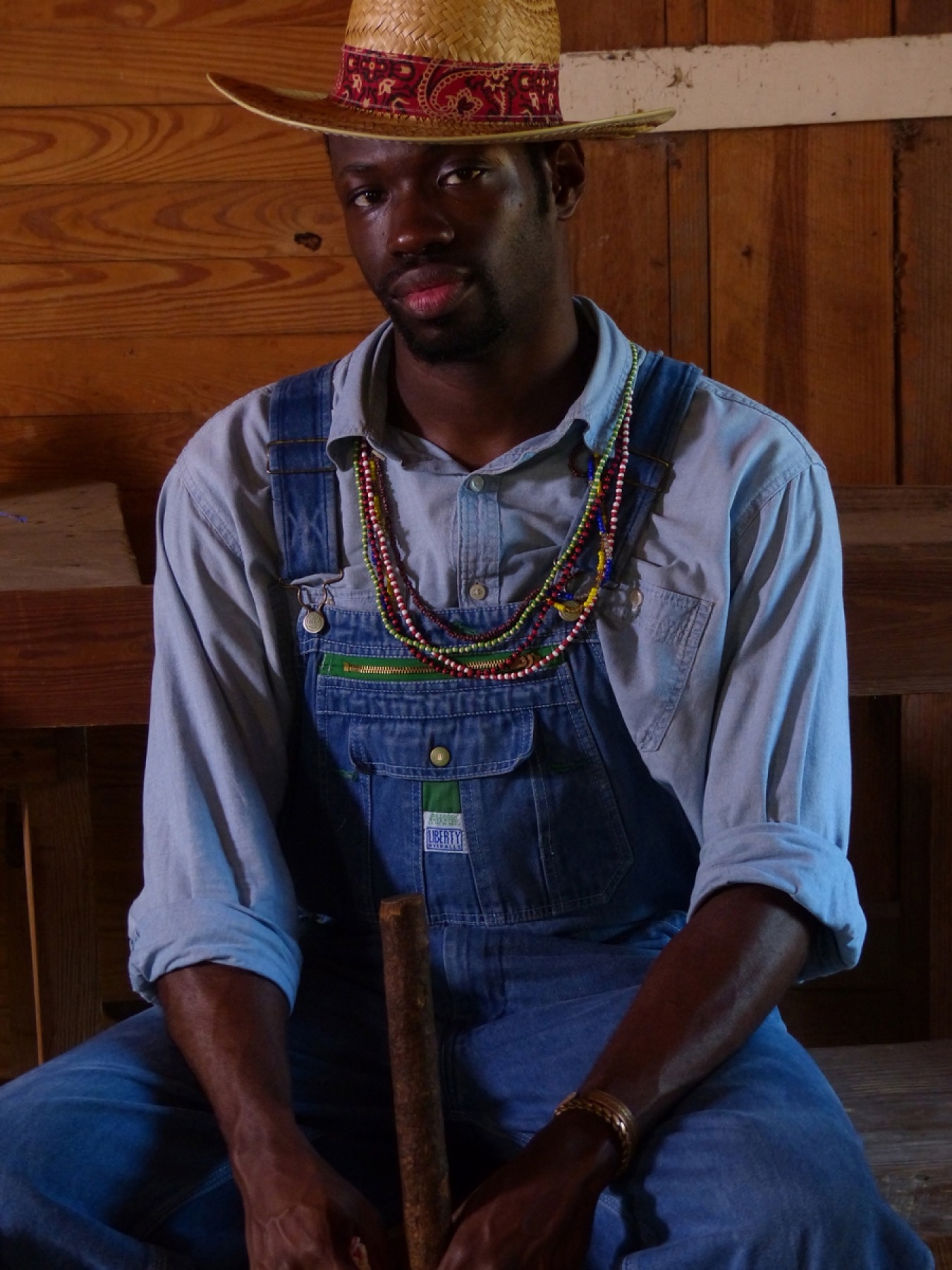
Brenton Jordan. Portrait by Margo Newmark Rosenbaum
LOST IN SONG
By Art Rosenbaum
Brenton Jordan is the stick-man and sometimes the lead songster of the McIntosh County Shouters, a group from Bolden, also known as “Briar Patch,” on the Georgia coast, the only community known to retain an unbroken practice of the slave ring-shout, the oldest African-American performance tradition on the North American continent. At twenty-nine, Brenton is the youngest member, and is ardent, articulate, and passionate about continuing the tradition—a fusion of call-and-response singing, percussive clapping, and beating a stick on a wooden floor—and the ring-shout itself, a shuffling counter-clockwise circle of “shouters.” The term refers to the dancelike movement, not the vocalization. In his study of the Gullah dialect, Lorenzo Dow Turner connected the Afro-Arabic term “saut,” pronounced “shout,” to the circular movement around the Kaaba in Mecca; and the term “shouting” is commonly used in African-American churches for ecstatic movement “in the spirit” rather than for vocalizing. Most of the shouts have biblical and sacred content, while some are secular and others carry messages of protest against slavery and oppression.
Brenton was not yet born in 1980, when patriarch shouter Lawrence McKiver agreed to organize a group to take the shout beyond the community, where it had been practiced mainly on New Year’s Eve (Watch Night), and perform it onstage for folk festival, concert hall, and university audiences. This was an important decision, mainly made to share more broadly both the venerable tradition that had sustained the “old ancestors,” as McKiver called them (specifically a slave-born couple, London and Amy Jenkins, who had passed the songs and the shout down at least five generations) and the often-encoded meanings of the songs and shout movements. McKiver put it best: “I don’t mind talking with a person on my heritage. I can bravely talk about my heritage, because my people come over the rough side of the mountain. Understand?”
Shout songs—a different genre from old hymns and spirituals—and other Gullah-Geechee customs had been recast as public performance years before the McIntosh County Shouters were formed, mainly by the Georgia Sea Island Singers. Frankie Quimby of the latter group told McKiver early on: “You don’t have to sing underneath my wing, you got good enough stuff to go and take to the public. I’ll help you and assist you and tell you all the turns.” I asked Brenton about Bessie Jones, one of the greatest of the Georgia Sea Island Singers (heard on the Oxford American’s Georgia Music CD singing “Diamond Joe”). He knew her only from her recordings, but said that she was a role model, and he recognized her importance in communicating the family and community legacy to a wider public.
Brenton is a college-educated, media-savvy young man of the twenty-first century but is happy to don the overalls and straw hats that the men of the McIntosh County Shouters wear. The women wear head rags and long-sleeved, floor-sweeping, old-fashioned dresses. These look like picturesque stage garb, but the clothing is understood to honor the earlier generations who labored and suffered and endured. When Brenton was a small child, he first attended a Watch Night shout and assumed it was something that “looks good, sounds fun”—just something the old folks had made up and did. Later he learned that it drew upon African roots and had come down from London and Amy Jenkins.
He started to beat the stick at five, and at nine learned his first shout song, “John on the Island.” He was a funny kid, who liked hanging around his elders. He learned much from casual “sit-down” sessions with his great-grandmother, who died when he was eleven; and he spent some time with McKiver, who lived to be ninety-seven and died in 2013. His inspiration on beating the stick was Benjamin Reed, the successor to Andrew “Bo” Palmer, who was the stick-man of the original performing group. The stick provides percussion and propulsion to the singing and the movement, and dates from slavery times, when drums were forbidden. Brenton respects the history and understands his responsibility to its integrity, yet, as master performers of vernacular art do, he is willing to advance the tradition through personal expression. As he put it, “I sing exactly as I learned it, but I venture into a song and pull out emotional true meaning—you literally get lost in a song.” He is aware of related forms in Belize, Brazil, Africa, and Jamaica. Immensely proud of the inheritance he carries forward, he says, “You may see dirt around, but I am sitting on a diamond.” When I asked if even younger people in the community are learning the ring shout, he named a few, like his cousin Carol, “an awesome shouter.” He is optimistic about the future: “This has survived three hundred years. I’d hope for it to survive three hundred years after I’m gone.”


